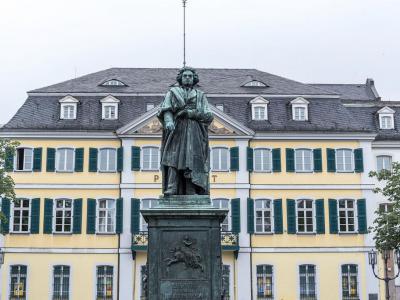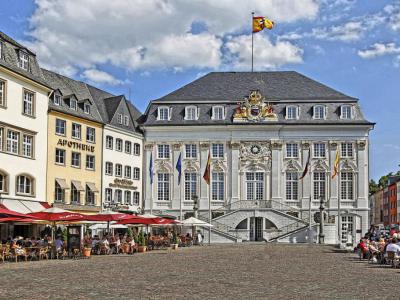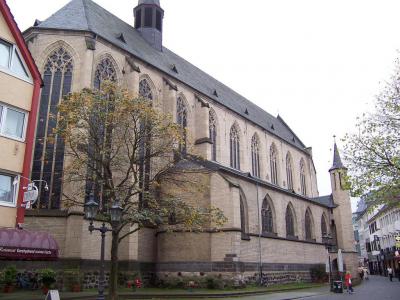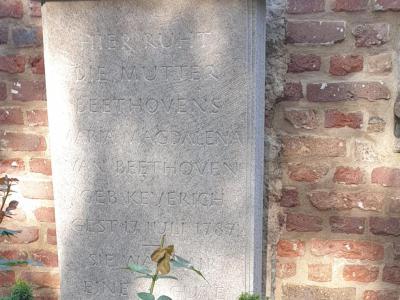
Beethoven Trail (Self Guided), Bonn
One of the most recognized music geniuses, whose works remain mainstays of the classical music repertoire around the world, Ludwig van Beethoven saw the light of day in Bonn in 1770. Needless to say that the legacy of the city’s most famous resident is highly respected and honored today. Indeed, Beethoven's presence is still very much felt throughout Bonn, encountering visitors in many places within the cityscape.
Beethoven was born at Bonnstrasse 20 in what is now known as the Beethoven House, the landmark birthplace museum founded in 1889, presently accommodating also the Beethoven Archive and Chamber Music Hall.
While there is no authentic record of the actual date of Beethoven's birth, the surviving registry of his baptism, in the Catholic Parish of St. Remigius on 17 December 1770, suggests that his birth date (a consensus with which Beethoven himself had agreed in the absence of other documentary proof) was 16 December, as per the then custom in the region to perform baptism within 24 hours of birth.
The Beethoven Monument, on Münsterplatz, unveiled in August 1845, commemorates Beethoven's 75th birthday on the occasion of the first Beethovenfest.
Another notable sight associated with Beethoven is the final resting place of his mother, Maria Magdalena van Beethoven, in the Old Cemetery. This simple gravestone, inscribed with the words: “She was such a good and kind mother to me, my best friend”, erected in 1787, was rediscovered only in 1932.
To explore these and other locations and to learn more about the life of Beethoven in Bonn, embark on this self-guided walking tour.
Beethoven was born at Bonnstrasse 20 in what is now known as the Beethoven House, the landmark birthplace museum founded in 1889, presently accommodating also the Beethoven Archive and Chamber Music Hall.
While there is no authentic record of the actual date of Beethoven's birth, the surviving registry of his baptism, in the Catholic Parish of St. Remigius on 17 December 1770, suggests that his birth date (a consensus with which Beethoven himself had agreed in the absence of other documentary proof) was 16 December, as per the then custom in the region to perform baptism within 24 hours of birth.
The Beethoven Monument, on Münsterplatz, unveiled in August 1845, commemorates Beethoven's 75th birthday on the occasion of the first Beethovenfest.
Another notable sight associated with Beethoven is the final resting place of his mother, Maria Magdalena van Beethoven, in the Old Cemetery. This simple gravestone, inscribed with the words: “She was such a good and kind mother to me, my best friend”, erected in 1787, was rediscovered only in 1932.
To explore these and other locations and to learn more about the life of Beethoven in Bonn, embark on this self-guided walking tour.
How it works: Download the app "GPSmyCity: Walks in 1K+ Cities" from Apple App Store or Google Play Store to your mobile phone or tablet. The app turns your mobile device into a personal tour guide and its built-in GPS navigation functions guide you from one tour stop to next. The app works offline, so no data plan is needed when traveling abroad.
Beethoven Trail Map
Guide Name: Beethoven Trail
Guide Location: Germany » Bonn (See other walking tours in Bonn)
Guide Type: Self-guided Walking Tour (Sightseeing)
# of Attractions: 5
Tour Duration: 1 Hour(s)
Travel Distance: 1.5 Km or 0.9 Miles
Author: damon
Sight(s) Featured in This Guide:
Guide Location: Germany » Bonn (See other walking tours in Bonn)
Guide Type: Self-guided Walking Tour (Sightseeing)
# of Attractions: 5
Tour Duration: 1 Hour(s)
Travel Distance: 1.5 Km or 0.9 Miles
Author: damon
Sight(s) Featured in This Guide:
- Beethoven Monument
- Market Square and Town Hall
- St. Remigius Church
- Beethoven House
- Maria van Beethoven Grave
1) Beethoven Monument
Heinrich Carl Breidenstein, Germany's first musicologist, was an ardent Beethoven fan. In 1832 he put forward the idea of a memorial to his idol, Ludwig van Beethoven, who had died in 1827. The idea caught on.
In 1835 the newly formed Bonn Association for the Beethoven Monument, captained by August Wilhelm Schlegel, a Shakespearean scholar, issued a call for a Beethoven monument. Hungarian composer and pianist Franz Liszt donated over 10,000 francs. Chopin, Schumann, Mendelssohn, and others quickly followed.
The contract was awarded to sculptor Ernst Julius Hahnel. The casting was done by Jakob Daniel Burgschmiedt of Nuremberg. The Beethovenfest began on Sunday, 10 August 1845. It was four days of music, dance, and fireworks.
The events were attended by Frederick William IV of Prussia, Queen Victoria, Prince Albert, and Archduke Friedrich of Austria. Hector Berlioz came, Robert Schumann and Felix Mendelssohn attended. Jenny Lind and Pauline Viardot showed with the mischievous Lola Montez, who embarrassed Liszt by dancing on a table.
The monument stands in front of the former Main Post Office on Munster Square ("Munsterplatz"). Most critics feel that the statue presents a good likeness of the composer. He stands on a base depicting instrumental, opera, spiritual and symphonic forms of music. His back is turned to the Old Main Post Office.
He glares into space, tight-lipped, chin up. He was reputed to be a rough character.
In 1835 the newly formed Bonn Association for the Beethoven Monument, captained by August Wilhelm Schlegel, a Shakespearean scholar, issued a call for a Beethoven monument. Hungarian composer and pianist Franz Liszt donated over 10,000 francs. Chopin, Schumann, Mendelssohn, and others quickly followed.
The contract was awarded to sculptor Ernst Julius Hahnel. The casting was done by Jakob Daniel Burgschmiedt of Nuremberg. The Beethovenfest began on Sunday, 10 August 1845. It was four days of music, dance, and fireworks.
The events were attended by Frederick William IV of Prussia, Queen Victoria, Prince Albert, and Archduke Friedrich of Austria. Hector Berlioz came, Robert Schumann and Felix Mendelssohn attended. Jenny Lind and Pauline Viardot showed with the mischievous Lola Montez, who embarrassed Liszt by dancing on a table.
The monument stands in front of the former Main Post Office on Munster Square ("Munsterplatz"). Most critics feel that the statue presents a good likeness of the composer. He stands on a base depicting instrumental, opera, spiritual and symphonic forms of music. His back is turned to the Old Main Post Office.
He glares into space, tight-lipped, chin up. He was reputed to be a rough character.
2) Market Square and Town Hall (must see)
The Market Square of Bonn is dominated by the Old Town Hall ("Altes Rathaus") built in 1737, during the time of Elector Clemens August. The Hall was built in the Rococo style by French architect Michel Leveilly. It was was heavily damaged in 1944 but it was successfully rebuilt without major changes in design.
The building has four stories and seven window axes and a Gambrel roof with dormers. It is well known for its gilded double staircase on two "folded" ramps at the main entrance. Charles de Gaulle, John F. Kennedy, and Mikhail Gorbachev are among the heads of state that have signed the Hall's Golden Book.
Another landmark is the obelisk of the Market Fountain standing in a pool at the center of the square. The 13th century church of Bonn Minster with its conical towers offers a place for meditation.
At the right of the Town Hall was the restaurant Der Zehrgarten, a meeting place of artists and society in Beethoven's time. It was a frequent haunt of young Beethoven who was a great admirer of Babette Koch, daughter of the manager. In November 1792 Beethoven made his farewell to friends in Der Zehrgarten before leaving for Vienna.
The building has four stories and seven window axes and a Gambrel roof with dormers. It is well known for its gilded double staircase on two "folded" ramps at the main entrance. Charles de Gaulle, John F. Kennedy, and Mikhail Gorbachev are among the heads of state that have signed the Hall's Golden Book.
Another landmark is the obelisk of the Market Fountain standing in a pool at the center of the square. The 13th century church of Bonn Minster with its conical towers offers a place for meditation.
At the right of the Town Hall was the restaurant Der Zehrgarten, a meeting place of artists and society in Beethoven's time. It was a frequent haunt of young Beethoven who was a great admirer of Babette Koch, daughter of the manager. In November 1792 Beethoven made his farewell to friends in Der Zehrgarten before leaving for Vienna.
3) St. Remigius Church
St Remigius Church of Bonn is dedicated to the memory of Bishop Remigius of Reims, the so-called "Apostle of the Franks." He baptized the emperor of the Franks, Clovis I, in 495 in Reims. The church was built by the Franciscan Order and consecrated in 1307.
It was originally dedicated to Saint Louis of Toulouse but it was taken over by the parish of Saint Remigius in 1806. Today, the church is a secondary church within the parish of Bonn Minster. It is also used by the Catholic university community. It is, in itself, a monument.
The church is in the old center of town on the Brother Street (Brüdergasse). It does not have a bell tower. This is a traditional mendicant style of buildings of the Franciscan Order. The church is a classic Gothic basilica with three naves. The central nave is very high and it has a steep sloping roof. It has a cross-ribbed vault dating from 1317.
The windows are high pointed arches in the Gothic manner. The rose window was installed in the pointed gable in 1889. It replaces three smaller pointed arch windows.
Johann van Beethoven and Maria Magdalena Keverich, parents of Ludwig van Beethoven, were married in the church in 1767. Ludwig was baptized there in December 1770. At the tender age of twelve Ludwig substituted for the main organist. He played the morning masses in the church. Within a year he was formally engaged as assistant organist.
It was originally dedicated to Saint Louis of Toulouse but it was taken over by the parish of Saint Remigius in 1806. Today, the church is a secondary church within the parish of Bonn Minster. It is also used by the Catholic university community. It is, in itself, a monument.
The church is in the old center of town on the Brother Street (Brüdergasse). It does not have a bell tower. This is a traditional mendicant style of buildings of the Franciscan Order. The church is a classic Gothic basilica with three naves. The central nave is very high and it has a steep sloping roof. It has a cross-ribbed vault dating from 1317.
The windows are high pointed arches in the Gothic manner. The rose window was installed in the pointed gable in 1889. It replaces three smaller pointed arch windows.
Johann van Beethoven and Maria Magdalena Keverich, parents of Ludwig van Beethoven, were married in the church in 1767. Ludwig was baptized there in December 1770. At the tender age of twelve Ludwig substituted for the main organist. He played the morning masses in the church. Within a year he was formally engaged as assistant organist.
4) Beethoven House (must see)
Bonngasse 20 and 24-26 in Bonn is Beethoven's birthplace and museum. It is in the center of town by a pedestrianized zone within walking distance of the Rhine River. Beethoven was born at Number 20 in December 1770. The house is among the last 18th century buildings to be found in Bonn.
The house has a baroque stone facade. It stands on cellars and foundations dating from the 12th or 13th centuries. A kitchen and a utility room are on the ground floor. On the floor above are three rooms, including one large room. The bedrooms are on the uppermost floor. The family moved in 1774 to Auf dem Dreieck square.
The Beethoven House is comprised of the actual birth house and a museum including courtyards. It is maintained by the Beethoven House Trust, founded in 1889. Bonngasse 18 and 24 to 26 house a research center with a Beethoven archive collection, a library and publishing house and a chamber music hall.
The house was located in a middle-class neighborhood peopled mainly by employees of the courts. After the Beethovens left for other digs, the house was variously a grocery, a beer garden, a concert hall, and a restaurant. The renovators of 1889 tried to preserve the building as it was in the 18th century.
The beer garden was replaced with a real garden and a paved courtyard with trellises. The building suffered comparatively minor damages in World War II. There were renovations in the 1950s and 1960s. Further renovations occurred in 1996. The Beethoven House was awarded the Europa Nostra award for heritage preservation in 1998.
The Beethoven House is the building in the front of the museum complex and the annex by the garden. Low ceilings, warped, creaking stairs and floors preserve an impression of life in Bonn in the 18th century. Experience a trip into the past in the collection of portraits, manuscripts, and instruments. The house has become its own exhibition.
The house has a baroque stone facade. It stands on cellars and foundations dating from the 12th or 13th centuries. A kitchen and a utility room are on the ground floor. On the floor above are three rooms, including one large room. The bedrooms are on the uppermost floor. The family moved in 1774 to Auf dem Dreieck square.
The Beethoven House is comprised of the actual birth house and a museum including courtyards. It is maintained by the Beethoven House Trust, founded in 1889. Bonngasse 18 and 24 to 26 house a research center with a Beethoven archive collection, a library and publishing house and a chamber music hall.
The house was located in a middle-class neighborhood peopled mainly by employees of the courts. After the Beethovens left for other digs, the house was variously a grocery, a beer garden, a concert hall, and a restaurant. The renovators of 1889 tried to preserve the building as it was in the 18th century.
The beer garden was replaced with a real garden and a paved courtyard with trellises. The building suffered comparatively minor damages in World War II. There were renovations in the 1950s and 1960s. Further renovations occurred in 1996. The Beethoven House was awarded the Europa Nostra award for heritage preservation in 1998.
The Beethoven House is the building in the front of the museum complex and the annex by the garden. Low ceilings, warped, creaking stairs and floors preserve an impression of life in Bonn in the 18th century. Experience a trip into the past in the collection of portraits, manuscripts, and instruments. The house has become its own exhibition.
5) Maria van Beethoven Grave
"She was to me such a good loving mother, my best friend." These are the words of Ludwig van Beethoven inscribed on the tombstone of his mother, Maria. The grave is at the Old Cemetery in Bonn. It is a simple grave covered with gravel. The headstone is an elongated rectangle of stone against a wall, flanked by evergreen shrubs.
Beethoven was sixteen years old when his mother died of tuberculosis. He was in Vienna, studying with Haydn and visiting with Mozart, when he received word his mother was dying. He had scarcely returned home in July 1787, when she passed away. His infant sister Maria Margaretha Josepha died shortly afterward.
The grave of Maria Magdalena was sold in 1826. All record of it vanished and the exact location was forgotten. It was rediscovered in 1932. The Beethoven House Society donated the headstone with the quotation by Ludwig. In the same cemetery are the graves of Robert Schumann and his wife, the pianist Clara Schumann.
Beethoven was sixteen years old when his mother died of tuberculosis. He was in Vienna, studying with Haydn and visiting with Mozart, when he received word his mother was dying. He had scarcely returned home in July 1787, when she passed away. His infant sister Maria Margaretha Josepha died shortly afterward.
The grave of Maria Magdalena was sold in 1826. All record of it vanished and the exact location was forgotten. It was rediscovered in 1932. The Beethoven House Society donated the headstone with the quotation by Ludwig. In the same cemetery are the graves of Robert Schumann and his wife, the pianist Clara Schumann.
Walking Tours in Bonn, Germany
Create Your Own Walk in Bonn
Creating your own self-guided walk in Bonn is easy and fun. Choose the city attractions that you want to see and a walk route map will be created just for you. You can even set your hotel as the start point of the walk.
Bonn Introduction Walking Tour
In 12 BC or thereabouts, the Roman army established in the Rhine valley, a large military encampment called "Castra Bonnensis." Literally "Fort Bonn." Built of wood at first and then replaced by stone, the fort lasted well into the 5th century AD.
The old fort materials were used to build Bonn's 13th century walls. The medieval city formed around the Romanesque church... view more
Tour Duration: 1 Hour(s)
Travel Distance: 2.4 Km or 1.5 Miles
The old fort materials were used to build Bonn's 13th century walls. The medieval city formed around the Romanesque church... view more
Tour Duration: 1 Hour(s)
Travel Distance: 2.4 Km or 1.5 Miles
The Most Popular Cities
/ view all






